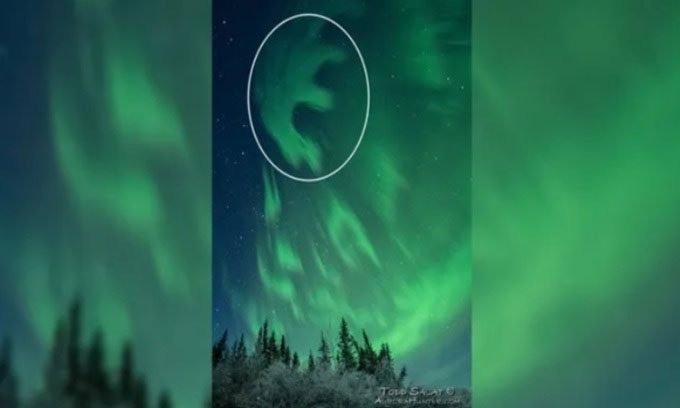Rare Black Aurora Creates E-Shaped Swirling Light in Recent Photos Over Alaska.
A strange E-shaped aurora was recently photographed in the skies over Alaska. This unusual light display was caused by a rare black aurora, also known as an anti-aurora, a phenomenon that pushes charged particles from the Sun away from Earth’s atmosphere and into space, according to Live Science on December 4.
Aurora hunter Todd Salat discovered the unusual aurora on November 22 at a location in south-central Alaska around 4 AM local time. The glowing E shape reportedly appeared suddenly and lasted for several minutes while transforming into various shapes, all containing dark patches not typically seen in most auroras.

The anti-aurora phenomenon creating an E shape hovering over the skies of Alaska. (Photo: Todd Salat).
“It came from the northwest, and I just gasped. It looked like the letter E. Within a few minutes, it changed and resembled some kind of insect floating in the air,” Salat recounted.
Anti-auroras are unusual phenomena that create many dark circular patches resembling ragged bites. True to their name, anti-auroras are essentially the opposite of regular auroras. They prevent gas molecules from releasing energy in the form of light. As a result, they create dark circles, twisting curls, or blotchy drops interspersed among vibrant colors, according to the European Space Agency (ESA).
Auroras are triggered when high-energy particles from the Sun, primarily electrons, penetrate Earth’s magnetic field or the thermosphere and superheated gas molecules. The excited molecules release energy in the form of light, merging into soft, elongated bands that undulate across the sky. Their colors vary greatly depending on the element being excited and their position in the atmosphere. Auroras typically occur near the poles, where Earth’s magnetic field is weakest. However, they have become particularly prominent and widespread due to increased solar activity during the solar maximum, the peak of the 11-year cycle.
However, anti-auroras disrupt the formation of regular auroras by causing gas molecules to lose charged particles. “Black auroras are not actually auroras. They represent a lack of auroral activity where electrons are pulled away from the ionosphere,” said Göran Marklund, a plasma physicist at the Royal Institute of Technology in Stockholm, Sweden.
Anti-auroras were first identified in the late 1990s. But in 2001, scientists discovered their operating mechanism when NASA’s four Cluster satellites flew through the space above the anti-auroras. The activity revealed small gaps in the thermosphere, where electrons are pushed back into space. A study conducted in 2015 using over a decade of data from the Cluster mission showed that these gaps form when auroras lose plasma, creating holes in the thermosphere.
Anti-auroras can occur in both the Northern and Southern Lights and typically last about 10 to 20 minutes. Experts predict that auroral activity will continue to be strong in the coming years.





















































